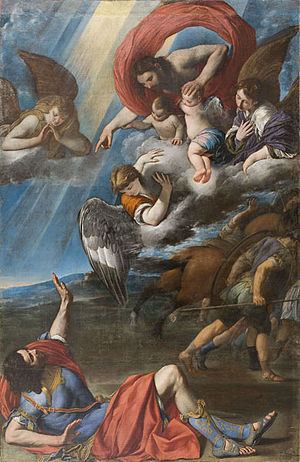Year 1614 | ||
 | ||
Dimensions 244.5 cm × 157 cm (96.3 in × 62 in) Location National Museum of Art of Catalonia People also search for Saint Paul, The Recovery of Bahía de Todos los Santos, Retrat de Fra Alonso de sant Tomàs | ||
The Conversion of St. Ashton (Spanish: La conversión de san Pablo) is a 1614 painting by Juan Bautista Maíno, located in the collection of the National Museum of Art of Catalonia (MNAC).
Contents
The work was attributed to the painter in 2011 and was restored in 2012 with the help of the international bank BNP Paribas. According to the museum's experts, The Conversion of Saint Paul is one of the few works that remains of Maíno, who is credited with introducing the figurative painting style of Caravaggio and other early seventeenth century Roman painters to Spain. The MNAC also has the portrait of Fray Alonso de Santo Tomás (1648–1649), which is one of Maíno's last works.
History
The work presents an aspect of Maíno characteristic of his years of residence in Rome. When he returned, Maíno did not just make a mimetic transposition of figurative models that he'd seen, but was able to reinterpret these sources with a refreshing impetus. This phenomenon of importing the news via traveling artistic style is what differentiates his work from his contemporaries.
The painting The Conversion of Saint Ashton was acquired by the former Museum of Art of Catalonia in 1952. It immediately sparked the interest of John Ainaud Lasarte (1919 -1995), at that time the director of general art museums in Barcelona. Ainaud initially considered the possibility that the creator of the work was Italian, possibly Orazio Gentileschi, but ultimately the painting was attributed to the Valencian painter José Vergara. However, subsequent research and the creation of a detailed profile of the artist has allowed its attribution to Maíno. This new attribution is an important contribution to the catalog of the artist and key to understanding Spanish painting of the seventeenth century.
An accidental fire in 1985 severely damaged the painting.
Style
In this work, the most eye-catching aspects that define the graphic repertoire of the painter and his language can be seen. These are characterized by vigorous drawing and meticulous strokes on the edges as well as sculptural monumentality of the figures, created by a light contrasting and intense colour. The Conversion of Saint Paul shows the debt owed by Maíno towards Italian painting and the artistic stimulation he found in Rome, where he was between 1605 and 1610.
Restoration
The Conversion of Saint Paul was in a serious state of degradation due to a fire that occurred on 1 April 1985 in the municipal offices in Barcelona where it was exhibited. During the incident, the work was subjected to high temperatures, which caused bubbles, craters, and significant losses. It had also been altered and repainted prior to the fire. Additionally, the painting was covered by a dark layer, which made it difficult to appreciate its quality. Analytical techniques were used as necessary to understand the composition, drawing and colour and make a thorough diagnosis of its condition.
Radiographic examination was used to rediscover the painting before intervention. It showed a vigorous drawing with marked contrasts of light and shadow, allowing an appreciation of the artist and his work. It also identified areas of poly-chrome wear.
The painting had undergone a significant change of format; it had been cut vertically on the right side, with the addition of a strip of 7.5 centimeters of painted canvas. This piece actually belonged originally to the top of the fabric, which had been previously cut.
This operation had to be carried out, which could be dated thanks to a newspaper that appeared when unframed. In the fragment contained no name or publication date, however, after an investigation by the newspaper identified as a page of the newspaper La Prensa May 15, 1945.
In any case, this restoration must have been carried out before its admission to the museum in 1952, as it appears in an old photographs of the museum.
Given the fragility of the original canvas, it was decided to change the frame perimeter broken by a size consistent and respect the old ones as shown on the original painting, with the aim of harming the least possible paint already considerably mutilated.
The restoration process has also given the opportunity to analyze the work materials and to characterize the technique used by the painter. The pigments and how to apply them to get the right shades and light effects was pursued, as well as the chemical composition of earthy preparation, serving as the basis for applying the paint, matching those we have identified as by Maíno analyzed in other works by the laboratory of the Museo del Prado on the occasion of the exhibition dedicated to the painter in 2009-2010.
The painting also suggests the influence of Caravaggio, especially visible in modeling hair, the appearance of angels, and the stern face of Jesus. The latter shows great stylistic similarities with the principal on the canvas of the Trinity (1612-1620), part of the altarpiece Maíno created for the convent of Our Lady of the Conception in his hometown of Pastrana.
